

Tested for you: the Nikon Z7 on the microscope
As we already mentioned in our camera review, the Nikon Z7 is an excellent full-frame mirrorless camera that comes with a host of great features. It has made the top 10 in our camera ranking for almost a year now, and we are happy to announce that we finally managed to test the Z7 in our laboratory to see how it performed on a microscope.
The Nikon Z7 is a mirrorless system camera with a 45.7 MP full-frame sensor. Its state-of-the-art sensor technology makes the camera exceptionally light sensitive, which, combined with an excellent dynamic range, ensures high-quality images even in poor lighting conditions. As well as high-resolution stills, the Nikon Z7 also shoots Ultra HD (4K). For presentations, the 4K live feed can be displayed on an external monitor connected to the camera via HDMI 2. The well-rounded package of features offered by the Z7 also can be put to good use on microscopes in a laboratory or studio setting.
Nikon’s Z series cameras (i.e. the Z6 and Z7) feature a new, larger-diameter mounting system (Z-mount), which enables the use of wide aperture lenses.

The camera can be mounted on almost any microscope using our adapter solutions with plan achromatic precision optics. Our LM microscope adapters are currently equipped with the specific Nikon Z-Mount. The camera housing can be connected directly to our adapter solution. The original Nikon FTZ adapter is no longer necessary.

Scheme: Nikon Z --> main adapter with Nikon_Z_Mount--> microscope
We generally recommend attaching the camera to the phototube of the microscope. Our wide-field adapter solution makes it possible to capture the largest possible field of view (FoV) without any vignetting.
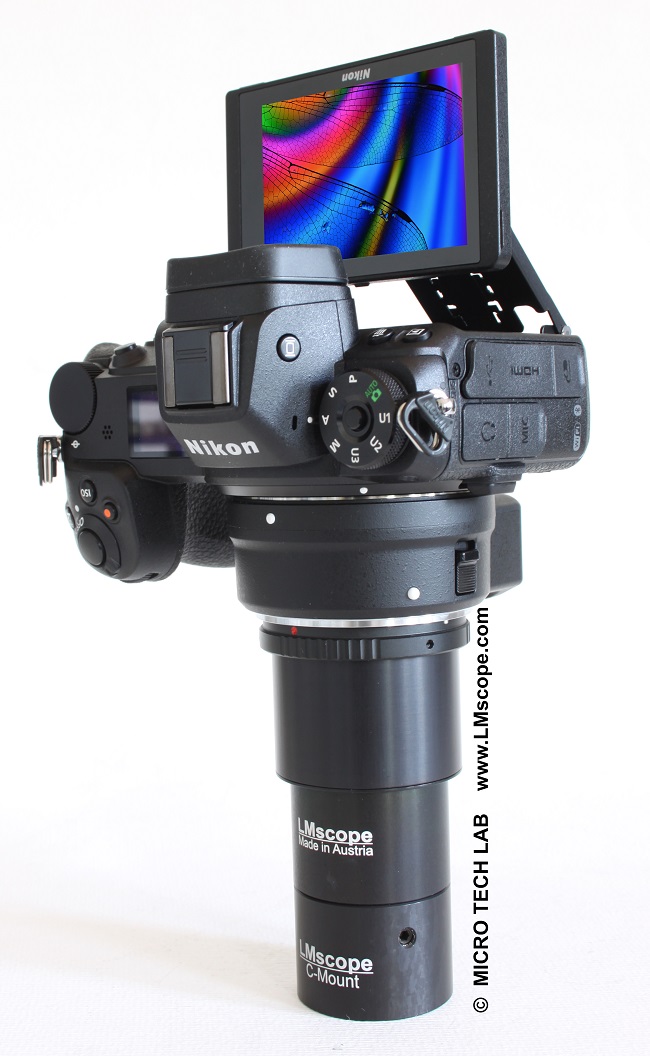
Together with the full-frame adapter, the camera delivers excellent results at pro-level quality.

As you can see in the image below, the adapter sits mostly inside the phototube, making the whole assembly very compact. The tilt-angle touchscreen makes working on the microscope-camera combination quite ergonomic.

If the microscope doesn’t have a phototube, connection via the eyepiece tube is also possible. The image quality is the same with either connection. The adapter system can be used flexibly and can also be transferred from one microscope to another in a few easy steps, because today’s eyepieces usually have a standard diameter of 23.2 or 30 mm.

In general, all important controls are easy to reach and arranged in a logical layout (such as the magnifying function, shown below, which is important for microscopy).
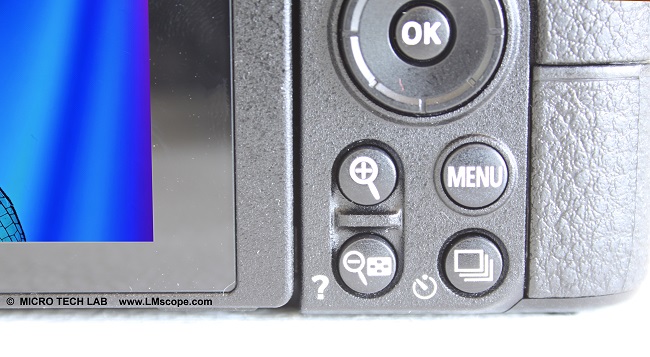
Extensive settings are available in the camera menu.
Image frame: FX (full-frame mode) or DX (crop mode):


Image quality: The Nikon Z7 enables users to capture images with different compression settings. The JPEG format is space-saving, while the TIFF format is uncompressed, but takes up a lot of file space.

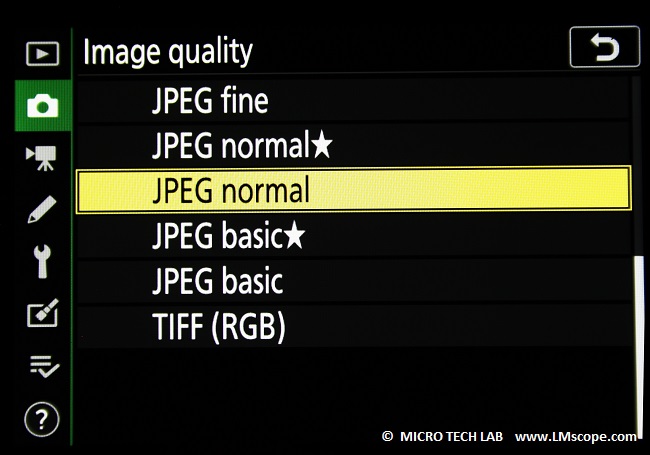
Image size:
- Large: 8256 x 5504
- Medium: 6192 x 4128
- Small: 4128 x 2752


HDR mode:
HDR (high dynamic range) imaging is a very useful feature for when pictures are taken in a laboratory of photo studio. It merges multiple photographs captured at different exposures into one image with a greater dynamic range than what is possible with standard imaging techniques. This is particularly beneficial for microscopy applications, because the gradients of brightness and colour are vastly improved.
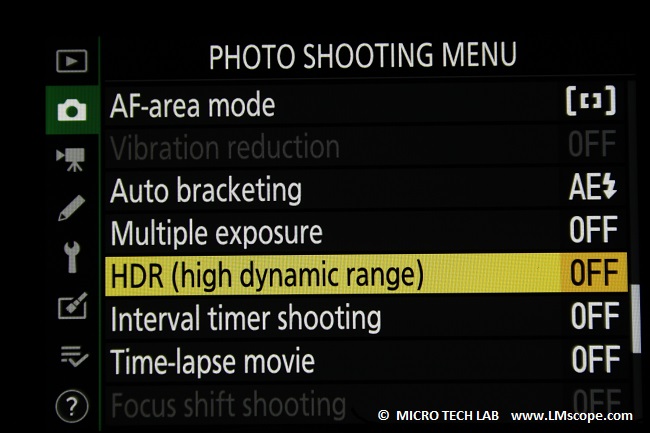

ISO sensitivity:
As always, you should keep in mind that the dynamic range of a camera generally increases as the ISO goes down (low ISO = best image quality). Therefore, if possible, the illumination should provide enough light to keep the ISO setting as low as possible and balance it out with shutter speed and aperture settings. The top standard ISO of the Z7 is 25,600, which can, however, be expanded manually.





Interval timer shooting:

Silent Mode for noiseless shooting:
The “Silent photography” menu item offers the option of noiseless shooting: the mechanical shutter is turned off and the camera switches to electronic shutter. This is a plus when shooting in bursts, which might cause the camera to vibrate somewhat and thus cause the image to become blurry.


Deactivate the standby timer
The standby timer delay affects how long the Live View screen will stay active. High-end cameras like the Z7 offer the possibility to deactivate this feature by setting the standby timer to “No limit”. For professional applications, such as educational presentations or Live View imaging in medical practices, it is essential to keep the camera in continuous operation and prevent it from automatically powering off.
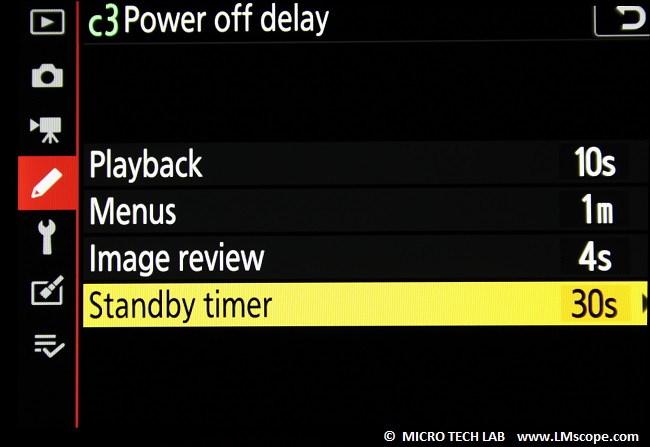


Not all cameras can provide continuous Live View operation, as this places high demands on the passive cooling system of the camera body. The sensor temperature after 30 minutes of Live View operation thus serves as an indicator of a camera’s quality. At 34.5 degrees Celsius, the Z7 also scores high in this respect. During the measurement time in our test, the sensor temperature increased continuously at first, but remained relatively constant after 30 minutes.

In older cameras, the sensor temperature was about 40 degrees, while the new Canon EOS R – the comparable competitor model – even comes in lower than the Z7 at 29.8 degrees. The sensor temperature is important because a cool sensor has a better signal-to-noise ratio and consequently a higher dynamic range. We think that the 5-axis image stabiliser behind the camera sensor has a slight impact on heat dissipation. The Canon EOS R has no image stabiliser in the camera body, which might be beneficial for temperature management.
The Nikon Z7 has the following interfaces: Wi-Fi, Bluetooth and USB-C 3.1 connection for fast data transfer and charging, which offers the convenience of no longer having to rely on an external charging unit. Also supplied with the camera is a matching charger.

Via its digital video port (HDMI 2), you can easily export the camera’s Live View feed to large high-resolution external 4K monitor. Of course, the Z7 also supports 4K (Ultra HD) mode.
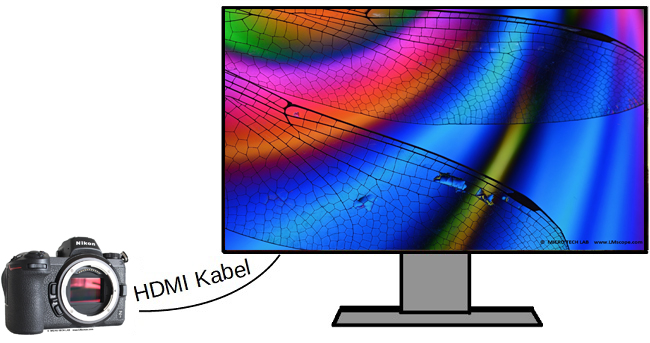
Like all current top-line system cameras, the Z7 is also capable of recording 4K (Ultra HD) videos with a resolution of 3840 x 2160 at up to 30 fps. For more beautiful colours, i.e. higher colour depth, Nikon offers its special “10 Bit N-Log” compression method for recording at a high 10-bit depth and increased resolution for each RGB channel. For slow-motion effects, the camera can record in Full HD mode (1920 x 1080) with a frame rate of 120 fps, amounting to 5x slow motion. Due to tariff regulations, the maximum clip length is 29 minutes and 59 seconds.
To prevent vibrations when releasing the shutter, we definitely recommend controlling the camera remotely from the PC/Mac with Nikon’s Camera Control Pro 2 software. The Live View image is conveniently displayed on the computer monitor and can be saved directly to the hard drive. The software costs about EUR 150 and can be purchased from photography stores or online retailers.
The Nikon Z7 also has built-in Wi-Fi, which can be used to connect mobile devices (smartphone or tablet) to the camera with Nikon’s free SnapBridge app. Once connected, the camera can be controlled remotely, and the smart device displays a Live View of everything the camera sees. The app can also be used for focusing and with one click, the shutter can be fired remotely to capture the image. We used an android tablet by Samsung with a high-resolution 10-inch display for our test.
Conclusion: We really liked the Nikon Z7. It blends state-of-the-art technology and a solid build quality into a well-rounded package. The current price tag (October 2019) is EUR 2,600 (body only). The Z7 also delivers an impressive performance on the microscope. To increase workflow efficiency, we recommend controlling the camera remotely from the PC/Mac with Nikon’s Camera Control Pro 2 software or via app from a smartphone or tablet.
17.10.2019